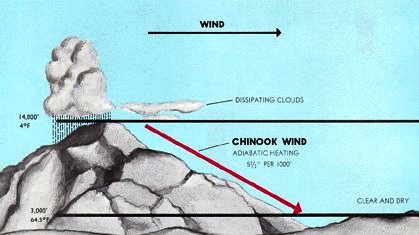
Back رياح الشنوك Arabic चिनूक Bihari Vent chinook Catalan Chinook (vítr) Czech Chinook (Wind) German Vento de Chinook Esperanto Chinook (viento) Spanish Chinook Estonian Chinook (haizea) Basque باد شینوک Persian
Chinook winds, or simply Chinooks, are two types of prevailing warm, generally westerly winds in western North America: Coastal Chinooks and interior Chinooks. The coastal Chinooks are persistent seasonal, wet, southwesterly winds blowing in from the ocean. The interior Chinooks are occasional warm, dry föhn winds blowing down the eastern sides of interior mountain ranges. The coastal Chinooks were the original term, used along the northwest coast,[1] and the term in the interior of North America is later and derives from the coastal term.[2]
- Along the Pacific Northwest coast, where the name is pronounced /tʃɪˈnʊk/ ('chin'+'uk'),[2] the name refers to wet, warm winds off the ocean from the southwest; this is the original use of the term.[1] The coastal Chinook winds deliver tremendous amounts of moisture both as rain along the coast and snow in the coastal mountains, that sustain the characteristic temperate rainforests and climate of the Pacific Northwest.

- In North American western interior, the same name is used for föhn winds, generally,[3] where the Canadian Prairies and Great Plains lie immediately east of various interior mountain ranges. There the name is pronounced /ʃɪˈnʊk/ ('shin'+'uk'). The same warm, wet coastal winds can also become the warm föhn winds on the eastern sides of mountain ranges, after having lost their moisture on the western sides; however, due to expanded use of the term in the interior for any föhn wind, interior Chinooks are not necessarily originally coastal Chinooks.
In the interior of North America, the Blackfoot people call these winds the "snow eater";[4] however, the more commonly used term "Chinook" originates from the name of the eponymous Chinook people, who lived near the ocean, along the lower Columbia River, where the term was first derived.[5] The reference to "a Chinook" wind or weather system originally meant, to euro-American settlers along the Pacific Northwest coast, a warming wind from the ocean blowing into the interior regions of the Pacific Northwest of the North America.
A strong föhn wind can make snow one foot (30 cm) deep almost vanish in one day.[6] The snow partly sublimates[7] and partly melts and evaporates in the dry wind. Chinook winds have been observed to raise winter temperature, often from below −20 °C (−4°F) to as high as 10–20°C (50–68°F) for a few hours or days, then temperatures plummet to their base levels.
- ^ a b Costello, J.A. (1909). "The Indian and the South Wind". Siwash — Indian History of the Northwest. pp. 156–158. Archived from the original on 2007-10-28: "p. 156". Archived from the original on 2008-05-30, "p. 157". Archived from the original on 2008-05-30, "p. 158". Archived from the original on 2008-05-30.
- ^ a b Cite error: The named reference
Tolmie-1884was invoked but never defined (see the help page). - ^ "Chinook wind". Encyclopædia Britannica. 2006.
- ^ "Snow Eater (The)". Telefilm Canada. 2013-10-17. Archived from the original on 2013-10-17. Retrieved 2019-05-14.
- ^ "Chinook – origin and meaning of the name "Chinook"". Online Etymology Dictionary (etymonline.com). Retrieved 2019-05-14.
- ^ Ahrens, C. Donald; Henson, Robert (January 2015). Meteorology Today : An introduction to weather, climate, and the environment (11th, student ed.). Boston, MA: Cengage Learning. p. 246. ISBN 978-1-305-11358-9.
- ^ "Sublimation – the Water Cycle, from USGS Water-Science School". water.usgs.gov.
© MMXXIII Rich X Search. We shall prevail. All rights reserved. Rich X Search